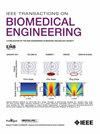mmWave Radar for Sit-to-Stand Analysis: A Comparative Study With Wearables and Kinect
IF 4.5
2区 医学
Q2 ENGINEERING, BIOMEDICAL
引用次数: 0
Abstract
This study investigates a novel approach for analyzing Sit-to-Stand (STS) movements using millimeter-wave (mmWave) radar technology, aiming to develop a non-contact, privacy-preserving, and all-day operational solution for healthcare applications. A 60 GHz mmWave radar system was employed to collect radar point cloud data from 45 participants performing STS motions. Using a deep learning-based pose estimation model and Inverse Kinematics (IK), we calculated joint angles, segmented STS motions, and extracted clinically relevant features for fall risk assessment. The extracted features were compared with those obtained from Kinect and wearable sensors. While Kinect provided a reference for motion capture, we acknowledge its limitations compared to the gold-standard VICON system, which is planned for future validation. The results demonstrated that mmWave radar effectively captures general motion patterns and large joint movements (e.g., trunk), though challenges remain for more fine-grained motion analysis. This study highlights the unique advantages and limitations of mmWave radar and other sensors, emphasizing the potential of integrated sensor technologies to enhance the accuracy and reliability of motion analysis in clinical and biomedical research. Future work will expand the scope to more complex movements and incorporate high-precision motion capture systems to further validate the findings.毫米波雷达坐立分析:与可穿戴设备和Kinect的比较研究。
本研究探讨了一种利用毫米波(mmWave)雷达技术分析坐立(STS)运动的新方法,旨在为医疗保健应用开发一种非接触、隐私保护和全天操作的解决方案。采用60GHz毫米波雷达系统收集45名参与者进行STS运动的雷达点云数据。使用基于深度学习的姿态估计模型和逆运动学(IK),我们计算关节角度,分割STS运动,并提取临床相关特征用于跌倒风险评估。将提取的特征与Kinect和可穿戴传感器获得的特征进行比较。虽然Kinect为动作捕捉提供了参考,但我们承认它与黄金标准的VICON系统相比存在局限性,后者计划在未来进行验证。结果表明,毫米波雷达有效地捕获了一般运动模式和大型关节运动(例如躯干),尽管对更细粒度的运动分析仍然存在挑战。本研究突出了毫米波雷达和其他传感器的独特优势和局限性,强调了集成传感器技术在提高临床和生物医学研究中运动分析的准确性和可靠性方面的潜力。未来的工作将扩大范围到更复杂的运动,并纳入高精度的运动捕捉系统,以进一步验证研究结果。
本文章由计算机程序翻译,如有差异,请以英文原文为准。
求助全文
约1分钟内获得全文
求助全文
来源期刊

IEEE Transactions on Biomedical Engineering
工程技术-工程:生物医学
CiteScore
9.40
自引率
4.30%
发文量
880
审稿时长
2.5 months
期刊介绍:
IEEE Transactions on Biomedical Engineering contains basic and applied papers dealing with biomedical engineering. Papers range from engineering development in methods and techniques with biomedical applications to experimental and clinical investigations with engineering contributions.
 求助内容:
求助内容: 应助结果提醒方式:
应助结果提醒方式:


